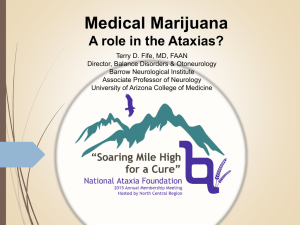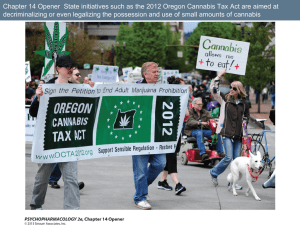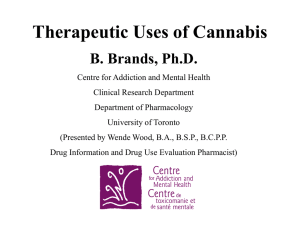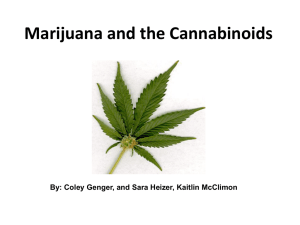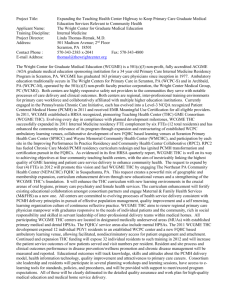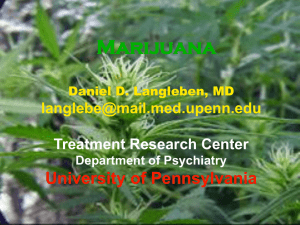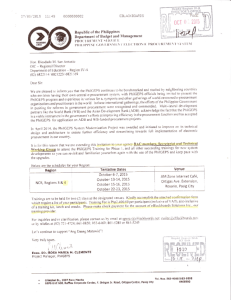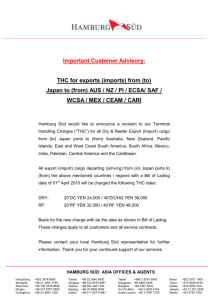Dr. med. Claude Vaney, Berner Klinik Montana
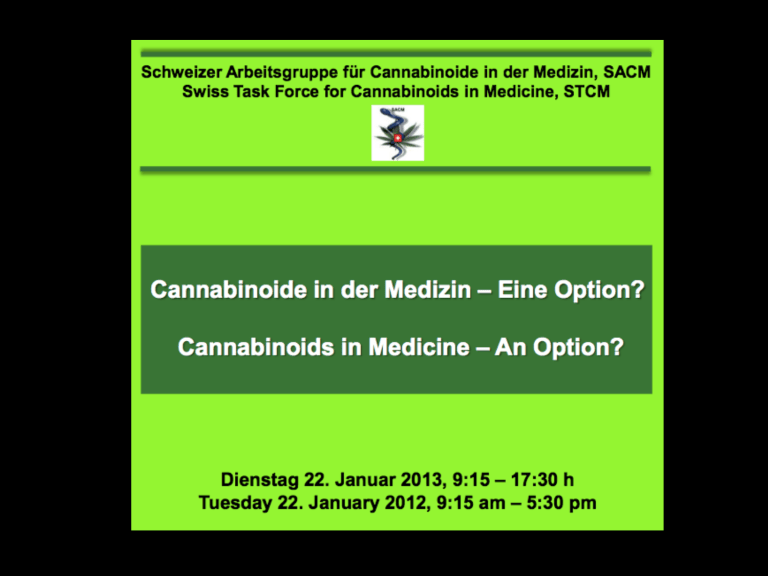
Medical use of
Cannabinoids in
Neurological Diseases
claude.vaney@bernerklinik.ch
Berner Klinik Montana
Crans-
Montana
Neurological rehabilitation clinic in the alps
300
PwMS/yea r
20 years ago in 1993...
28 y old MS patient: can barely stand on his own, walks a few steps only with aid and suffers from severe spasms in his legs
Lioresal, Sirdalud +Valium ...
Did not work ,were badly tolerated and made him tired
Is there anything that helps you?
“I smoke a joint!”
1998
Request to the FOPH (Federal Office of
Public Health) for a special authorisation to prescribe Marinol®
(=capsules of synthetic delta - 9- THC) reply of the FOPH:
….no evidence that THC works in MS spasticity...
..but we are ready to finance a study in your clinic!
THC for MS - Studies before 1998
Studie
Petro
1981
Clifford
1983
Ungerleider
1986
Brenneisen
1996
Meinck
1989 n
10
8
13
2
1
Form
Thc oral
Thc oral
Thc oral
Thc supp
Thc joint
Wirkung
Spastik
Tremor
+/-
Spastik
Spastik
Ataxie
Plantextract
THC : CBD = 2 :1
Cannabidiol (CBD) minimizes the psychoactive effects of THC and delays their onset…
Pharmacological properties of the 2 main cannabinoids
Tetrahydrocannabinol
(THC)
Antiemetic
Cannabidiol
(CBD)
Analgesic
Muscle relaxant
Appetitstimulation
Psychoactive
Anticonvulsant
Anxiolytic
Neuroprotective
Asworth score (0-4) didn’t change more on verum than on placebo verum =THC
Not significant
The comparison of the patients spasm protocol is significant p = 0,013 verum =THC placebo
Editorial:
The therapeutic value of cannabinoids in MS: real or imaginary ?
Killestein J. Mult Scler 2004
Sirven JI and Berg AT
Marijuana as a treatment for
Epilepsy and MS ?
Neurology 2004;62:1924-25.
....or is it cruelly hoaxing on vulnerable patients who have lost hope ?“
19
ième
: golden age of Cannabis
• Prescribed for : cholera, tetanos rheumatisms, sleeplessness and pain…
„On the preparation of indian or gunja “
William B. O ‘ Shaughnessy, 1839
Reynolds Sir J.R.
Therapeutic Uses &
Toxic Effects of Cannabis Indica.
(Lancet 1890)
"One of the most valuable
medicines we possess...“
20 Jh. : „Discredit “
More potent analgesic drugs such as aspirine
Injectable drugs (opiods)
Marijuana tax act 1937:
Hemp seen as danger for the cotton industry..and for the youth.!
In 1961 the United Nation single convention on narcotic drugs declares that cannabis has no medical or scientific benefit !
Gaoni & Mechulam
J Am chem Soc 1964
1964, the cannabinoid ∆ 9 Tetrahydrocannabinol (THC) was identified as the primary psychoactive substance of the hemp plant.
Recent clinical trials point to the prospect of cannabis as a medication in the treatment of multiple sclerosis
Pryce G & Baker D. Trends Neuroscience 2005
Publications on THC & MS
96
125
09-10 11-12
The clinical consequences of demyelinisation
Impaired electric conduction
The clinic depends on the localisation of the sites of demyelinisation pyramidal tracts weakness/spasticity posterior columns pain brain
Hirn cerebellum ataxia autonomic system bladder & sexual problems optic nerv loss of vision brainstem diplopia cortex cognitive & emotional changes
„Plaque “ inflammation
Spinal cord nerv muscle
In spite of the disease modifying drugs
MS is a chronic progressive disease
(
Roxborough RH et al. Neurology 2005) town house room
They suffer from being immobile
“I am a burden for my family…”
They have neuropathic pain and suffer from muscle spasms
La columna rota 1944 F.Kahlo
Museo Dolores Olmado - Mexico
Incontinence makes their life miserable and prevents them from going out
Prevalence of medicinal cannabis use among patients 15 %.
Clark AJ et al. Neurology 2004
Gebrauch zu medizinischen Zwecken
(Ware MA , Int J Clin Pract 2005)
• Review 1998- 2002 in UK
• 3663 Fragebogen (R‘lauf:2669; 73%))
• Hanf Gebrauch:
– Chronischer Schmerz 25 %
– Multiple Sclerosis 22 %
– Depression 22 %
– Arthritis 21 %
– Neuropthischer Schmerz 19 %
Properties of an ideal drug for MS?
• Slow down progression
• No serious side effects
• Reasonable costs
• Favorable effect on symptoms
Favorable on what symptoms ?
• Lower spasticity
• Reduce pain
• Calm the bladder
• Increase mobility
• Slow down progression ?
• No serious side effects
• Low cost
• Favorable effect on symptoms
La fontaine de jouvence 1546
J.Cranach Nationalgalerie - Berlin
Cannabinoids slow down progression...
CB1 deficient mice tolerate inflammatory and exotoxic insult poorly and develop substantial neurodegeneration following immun attack. ( Pryce G et al. Brain 2003)
Cannabinoids slow down progression...
•In vitro evidence that cannabinoids can reduce glutamate (=neurotoxin) release.
( Hampson AJ et al. Proc Natl Acad Sci USA 1998)
Endogenous cannabinoids participate in retrogrde signalling
(Wilson RI, Nicoll RA. Science 2002; 296: 678-82)
Neurotransmitter
(eg.Glutamat,Dopamine)
+
Receptors
CB1 receptor
endocannabinoids:
Anandamid, 2-Arachidonglycerol
By pre-synaptic inhibition endocannabinoids modulate the flow of information from one cell to the other !
RCT with THC for other neurological diseases
Disease Author n Thc form Results
Motorneuron disease
Idiopathic
Parkinson
Tourette‘s
Syndrome
Huntington
Disease
Weber M.
JNNP
2010
Sieradzan KA
Neurology
2001
27
7
Thc oral
2 X 5mg
Thc oral
Müller-Vahl KR
Pharmacopsy
2002
12
Thc oral (single)
5;7.5,10mg
Curtis A
Mov Disord
2009
44
Nabilone
Synthetic THC
No effect on cramps improvement of dyskinesia
Less motor tics
Positive on chorea & behaviour
THC reduces the relapse rate !
CAMS Study- J.Zaijcek , Lancet 03
CUPID Study 2008-2011 in the UK with 500 PwMS (2Mio £)
Cannabinoid use in progressive inflammatory brain disease
Cannabis ?
•Slow down progression
•No serious side effects ?
•Low cost
•Favorable effect on symptoms
What are the comments concerning side effects ?
• Zaijcek et al. Lancet 2003
„Number of serious events are similar across the treatments, with slightly more events in the placebo group“
• Wade DT et al. Mult Scler 2004
„Most people achieved benefit without troublesome side effects“
The available clinical trial data suggest that the adverse side effects associated with using CBMEs are generally mild, such as dry mouth, dizziness, somnolence, nausea and intoxication.
There may be reason to be concerned about the use of therapeutic cannabinoids by adolescents , people predisposed to psychosis and pregnant women.
The psychiatric side of Cannabis effects are well known...
…And he who has an empty brain and eats hemp, it will cause him some pain in the head.
But it does not harm the healthy head and the full brain.
Hildegard von Bingen 1098-1179
(In Physica)
Side effects were also found in
patients taking placebo...
Vaney et al. Mult Scler 2004
Effect of centraly active drugs on the web building activity of a new species of indian spider
Mardikar BR et al. Indian Med Sci 1969; 10:550-8
LSD Cannabis Meskaline coffee
• Slow down progression
• No serious side effects
• Low cost ?
•Favorable effect on symptoms
• Cheaper than DMS...
A,B,C ~ 20 000.- /y
The price of pain relief /day
30
25
20
15
10
5
0
27
12
10
1.2 0.5
Source :F.Grotenhermen Hanf Journal 06/06
•Slow down progression
•Few side effects
•Low cost
•Favorable effect on symptoms ?
Favorable effect on symptoms:
•Lower spasticity ?
•reduce pain
•Calm the bladder
•Increase mobility
What can be done against pain and muscle spasms ?
Drugs commonly used to lessen spasticity and spasms
Shakespeare DT, Boggild M, Young C. Anti-spasticity agents for multiple sclerosis (Cochrane Review 2003)
Baker D et al. Nature 2000; 404: 84-87
Cannabinoids control spasticity and tremor in a multiple sclerosis model
Baker D et al. Nature 2000; 404: 84-87
Cannabinoids control spasticity and tremor in a multiple sclerosis model
Reduced spasticity ...subjectively
Study
Ungerleider
1987
Vaney
2004
Zaijcek
2003
Wade
2004 n Measure Spasms
13
57
667
160
Subjective rating
Spasm frequency
Category rating scale
VAS improved improved
P=0.013
Improved
P =0.01
Improved
P=0.001
•Lower spasticity
•reduce pain ?
•Calm the bladder
•Increase mobility
Converging evidence supports a role of endocannabinoids in the tonic inhibition of pain responses and the setting of nociceptive thresholds .
.
Dynamic regulation of the endocannabinoid system: implications for analgesia
Sagar D et al. Mol Pain 2009; 5: 59.
Cannabinoids and Pain Pathways
Thalamus
Adapted from Di Marzo 2001
+
Periaqueductal grey Possible sites of action
Endocannabinoids
+
+
Rostral ventromedial medulla
?
-
Dorsal horn of spinal cord
Dorsal root ganglion
A² , A §
&
C-fibres
Peripheral terminals of primary afferent neurons
That takes away neuropathic pain !
Rog DJ et al. Neurology 2005
0
2.7
(Cannabis) 10
1.4
(Placebo)
?
Visual analog scale (VAS)
Cannabis Spray licensed Sativex® in Canada in 2005
Reduced pain ...subjectively
Study
Zaijcek
2003 n
667
Svendson
2004
24
Brady
2004
Wade
2004
14
160 time
15 w
3 w
35 w
6w measure
Category rating scale
Numerical rating scale (0-10)
VAS
VAS pain
P =0.002
P=0.02
P <0.05
0.243
•Lower spasticity
•reduce pain
•Calm the bladder ?
•Increase mobility
What can be done against incontinence ?
Background
• CB1 receptors exist in the mouse bladder (Pertwee and Fernando,
1996) and in regions of the central nervous system associated with bladder control (Glass, 1997).
•Cannabinoids can reduce bladder hyperreflexia induced by inflammation in rats (Jaggar and
Rice, 1998; Jagger et al., 1998)
Before
Intraperitoneal administration of THC
AGONIST/ WIN 55,212-2 IP
During After
40 cm H
2
O
Before
ANTAGONIST/ SR 141716A IP
During After
0 cm H
2
O
80 cm H
2
O
0 cm H
2
O
Brady CM et al. Mult Scler 2004
• 15 patients
• THC : CBD Spray
• Urinary urgency
• Incontinence episodes
• Nocturia
•Lower spasticity
•reduce pain
•Calm the bladder
•Increase mobility ?
(Vaney et al. Mult Scler 2004)
What would happen to our lady if she could take some Cannabis
?
By taking cannabinoids she will spend a wonderful afternoon moving around without any pain or episodes of incontinence !
A wonder drug for people with Multiple Sclerosis !
Sorry, I have led you astray...
In the follow up study there was no difference in the relapse rate between THC and Placebo
Zajicek J.P. et al. JNNP 2005
CUPID Study 2008-2011 in the UK with 500 PwMS (2Mio £)
Cannabinoid use in progressive inflammatory brain disease
Cannabis ?
CUPID Study 2008-2011 in the UK with 500 PwMS (2Mio £)
Disease progression could not be stopped ☹
Spasticity as the primary outcome measure was not significantly reduced
Study
Ungerleider
1987
Killestein
2002
Zaijcek
2003
Vaney
2004 n
13
16
667
57
Ashworth ns ns ns ns
Spasm/ well being improved worse with THC improved
Only trends in favour of THC
•
CMAJ july 2012
•
30 PwMS
•
3 times daily
1 cigarette placebo vs. cannabis
•
Ashworth spasticity score (0-5)
There seems to be a tendency that the more disabled persons are more motivated to continue the treatment number age continue stopped
66
54.1
44
55.4 women 54% 57%
EDSS 6.8
± 1.6 6.1
± 1.9
« Gut schweizerischer
Kompromiss..”
Throwing the baby with the bath water
... In the meantime, when other treatment inadequatly controls spasticity, oral cannabinoids should be considered...
(L.Metz, Lancet 2003)
While 2-3 years ago there was little consensus in the literature, now the majority of studies are beginning to suggest that cannabinoids are useful in the treatment of MS in at least a subset of individuals…
Smith PF Expert Rev Neurother 2007
MUSEC Study (Zaijek et al.)
Multiple Sclerosis and Extract of Cannabis
JNNP 2012
Double blind placebo controlled study with
279 patients with MS (PwMS)
•
2 week dosefinding
•
10 weeks treatment with THC / CBD caps.
•
CRS (Category Rating Scale) 0-10
•
Muscle spasm, sleep, pain and mobility
•
Placebo 15.7 % improved
•
Verum 29.4 % improved
Sativex®
Checkliste: Ausnahmebewilligung Marinol (& Dronabinol)
• Arzt trägt volle Verantwortung für alle Folgen
• Name , Geburtsdatum und Adresse des Patienten
• Schriftliche Einverständniserklärung des Patienten
• Liste der bisher eingesetzten Medikamente
• Beabsichtigte Dosierung & Behandlungsdauer
• Zwischen berichte & Schlussbericht verfassen
• Art der Überwachung und Betreuung des Patienten
• Logistik für die Abgabe des Medikaments
(Arzt, öffentliche Apotheke oder durch ein Spital?)
• Art der Finanzierung der Therapie
Bundesamt für Gesundheit
Nationale Präventionsprogramme
Sektion Grundlagen
Schwarztorstrasse 96
CH-3003 Bern
Telefon:+41 (0)31 323 87 93
The therapeutic value of cannabinoids in
MS: real or imaginary ?
Thanks for your attention
